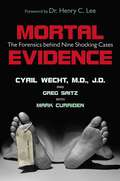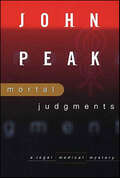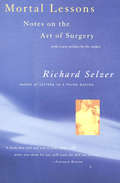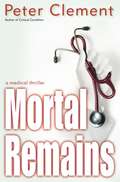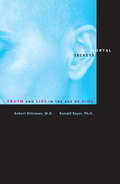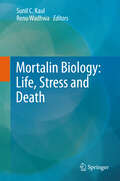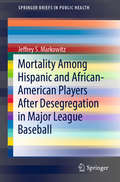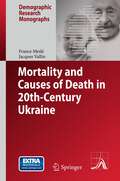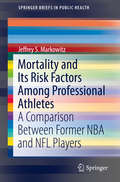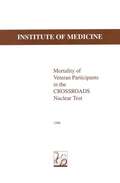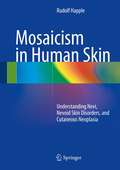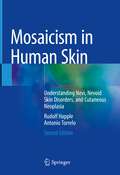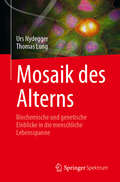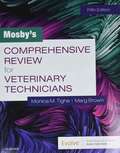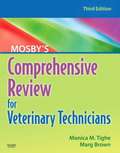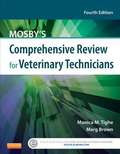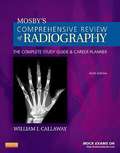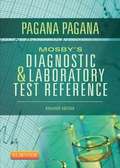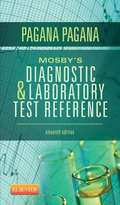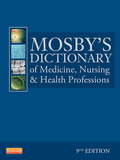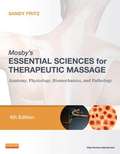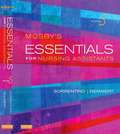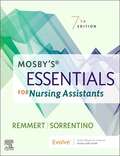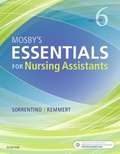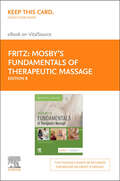- Table View
- List View
Mortal Evidence: The Forensics Behind Nine Shocking Cases
by Cyril H. WechtA lifeless newborn baby is found discarded in a motel Dumpster. Authorities quickly arrest the infant's teenage parents, charging them with murder. Did Amy Grossberg and Brian Peterson, in fact, murder their own baby? Tammy Wynette died suddenly at a relatively young age, and yet no autopsy was performed? Was someone trying to hide the real cause of death? Did Sam Sheppard (later dubbed "The Fugitive" based on a television series) really kill his wife? And if not, who committed the murder? Things are not always as they appear, as world-renowned forensic pathologist Dr. Cyril Wecht shows in this riveting behind-the-scenes look at nine famous cases. In the nationally known baby case involving Amy Grossberg and Brian Peterson, Dr. Wecht reviews the evidence and comes to a startling conclusion. In fascinating detail, he demonstrates how the tools of forensic pathology often uncover murky, long-hidden secrets that crack seemingly unsolvable crimes. Writing in the first-person Dr. Wecht leads you into the heart of the investigation, focusing each chapter on a single engrossing drama. He reveals the most startling evidence that shows why JonBenet Ramsey's killer most likely came from within her home, why O.J. Simpson probably had an accomplice in the murder of Nicole Simpson and Ron Goldman, shocking revelations about Robert Berdella's grisly torture and sex-abuse crimes against young men, and many intriguing facts about other infamous cases. If you find the fictional plots of such dramas as C.S.I. exciting, you will be amazed by the true stories told by Dr. Wecht, with the help of two top-flight veteran reporters, Greg Saitz and Mark Curriden, in this amazing real-life thriller. As this intriguing page-turner proves, the science of forensic pathology has changed the face of detective work forever.
Mortal Judgment: A Legal Medical Mystery (The Vicki Shea Series)
by John A. PeakVicki Shea, a San Francisco malpractice lawyer with a medical degree, is a good choice for surgeon Arnold Jones. Jones faces a malpractice suit that could virtually wreck his career. He is accused of having caused the sudden death of a rich and powerful businesswoman. He is urged by everyone to settle, but he refuses. He knows he wasn't at fault, and won't say he was.As Vicki begins work on the case, she finds that someone wants her to stop: a concrete block is dropped on her car on the freeway; there is missing information on the death certificate; both pathologists who look into the case for Vicki die suddenly; and the attemps on Vicki's life escalate.In this dramatic thriller, where every medical and legal detail is accesible and engrossing, Peak has written his best and most important book yet.
Mortal Lessons: Notes on the Art of Surgery
by Richard SelzerA surgeon shares true stories of life, death, and the human body in an essay collection that &“will nail you to your chair&” (Saturday Review). With settings ranging from the operating theater to a Korean ambulance, and topics as varied as the disposition of a corpse and the author&’s own childhood, these nineteen captivating, wry, and intimate vignettes offer a poignant examination of health, humanity, and, of course, mortality. Sometimes tragic, sometimes humorous, the essays offer a physician&’s viewpoint that goes beyond the medical to also consider the most meaningful issues and questions we face, whether as doctors or patients, cared for or caregiver. Praised by Kirkus Reviews as &“an impressive display of knowledge and art, magic and mystery,&” Mortal Lessons is a classic reflection on the human body and the human experience, and will resonate with readers for generations to come.
Mortal Remains (Dr. Earl Garnet #4)
by Peter ClementIn a small upstate New York town, an idyllic lake yields a ghastly discovery when the skeletal remains of a young woman missing for twenty-seven years are pulled from the icy depths--along with unmistakable evidence of her murder. Suddenly, the long-dormant case of Kelly McShane Braden's mysterious disappearance is reactivated. And for two devastated men, dark emotions and disturbing secrets will also rise to the surface. For local coroner Dr. Mark Roper, the murder is more than just a grim interruption of his general practice in sleepy Hampton Junction. Kelly Braden had been a surrogate sister. When the police insist the trail of Kelly's disappearance is too cold to pick up again, he vows to find the missing pieces of the past that will lead him to a killer. Because that's what cracks cold cases: "One guy who can't get it out of his head. " Yet Mark isn't the only one with Kelly's murder on his mind. Dr. Earl Garnet, chief of staff at Buffalo's St. Paul's Hospital, was once Kelly's secret lover . . . and would-be savior. Until his plans to rescue her from an abusive marriage were cut short by her vanishing. Now, as the last person to see Kelly alive, he's in danger of becoming the prime suspect, unless he can unmask the murderer first. But neither man knows about the twisted chain of lies and corruption that led to Kelly's death--or the shocking revelations that were meant to go with her to a watery grave. And the harder they push for answers, the easier they make it for their lethal quarry to zero in on them--and push back with deadly force. WithMortal Remains, Peter Clement remains in total control of readers' nerves from the very first page, once more wielding heart-racing suspense and scalpel-sharp terror with a master surgeon's skill. From the Hardcover edition.
Mortal Secrets: Truth and Lies in the Age of AIDS
by Ronald Bayer Robert KlitzmanIn the era of the Internet and Oprah, in which formerly taboo information is readily available or freely confided, secrecy and privacy have in many ways given way to an onslaught of confession. Yet for those who are HIV positive, decisions about disclosure of their diagnosis force them to confront intimate, fundamental, and rarely discussed questions about truth, lies, sex, and trust.Drawing from interviews with over seventy gay men and women, intravenous drug users, sex workers, bisexual men, and heterosexual men and women, the authors provide a detailed portrait of moral, social, and psychological decision making. The interviews convey the complex emotions of love, lust, longing, hope, despair, and fear that shape individual dilemmas about whether to disclose to, deceive, or trust others concerning this disease. Some of those interviewed revealed their diagnosis widely; others told no one. Some struggled and ultimately told their partners; others spoke in codes or half-truths. One woman discovered her husband's diagnosis in a diary; when confronted, he denied it.Each year in the United States, 40,000 new cases of HIV arise, yet approximately one-third of the 900,000 Americans who are infected do not know it. As treatments have improved, unsafe sexual behavior has increased and efforts at prevention have stalled. Many of those infected continue to fear and experience rejection and discrimination. Addressing broad debates about the nature of secrecy, morality, and silence, this book explores public policy questions in the light of the nuanced, private decisions that are shaping the course of an epidemic and have broader indications for all.
Mortalin Biology: Life, Stress and Death
by Renu Wadhwa Sunil C. KaulThe phrase "Life, stress and death" connects three terms, but is there a biological basis for that? Are there molecules that are essential to/or mediate these phenomena? This contributory volume "Mortalin Biology: Life, Stress and Death" is a remarkable compilation of the research outcomes on the stress protein mortalin, a member of heat shock 70 family of proteins. The book is unique as it describes mortalin playing essential role in life, stress response and death either from cancer, when it becomes hyperactive or from neuro-degeneration, when it becomes hypoactive. The book provides up-to-date knowledge on mortalin with respect to its discovery, structure, evolutionary conservation, function and signal transduction in different organisms in a simple, but most comprehensive way, that besides offering an enjoyable and in-depth reading, prompts the reader to ask further questions to explore this protein with new ideas, approaches and experiments. Twenty-one chapters by the world leaders on the specific areas of mortalin research throw light on its multi-functionality, potentials for biotechnology, diagnostics and therapeutic values. Avenues of mortalin biology, yet unexplored, hold immense promises for future, and reading this volume provides an easy, enthusiastic and energetic head-on start.
Mortality Among Hispanic and African-American Players After Desegregation in Major League Baseball (SpringerBriefs in Public Health)
by Jeffrey S. MarkowitzThis compelling book examines mortality risk among former Hispanic and African-American players in Major League Baseball (MLB) during the 40-year period following desegregation in the League. Analyzing a variety of biological, cultural, social, and environmental factors, the author illustrates the potential health effects of racial disparities on these elite athletes and fills a significant gap in the mortality literature.Included in the coverage:The history and evolution of professional baseball in both the United States and Latin AmericaLiterature and statistical reviews of racial and ethnic inequalities in mortality in the US general populationOverview and evaluation of methodologies used to statistically analyze mortality risk in this professional-athlete populationImplications and applications of research findings related to Hispanic and African-American MLB-player mortalityA unique perspective on a pressing public health issue, Mortality Among Hispanic and African-American Players After Desegregation in Major League Baseball is a salient read for public health professionals including epidemiologists, medical professionals, and social scientists, as well as athletes, historians, and those with broad interest in African American and Latino health.
Mortality and Causes of Death in 20th-Century Ukraine
by Jacques Vallin France Meslé Vladimir Shkolnikov Sergei Adamets Serhii PyrozhkovThe Ukraine faced two very different kinds of health crises during the twentieth century. First, in the 1930s and 1940s, famine, war and political upheaval caused massive population losses. Previous evaluations of overall losses have given an idea of the scale of these catastrophes but do not distinguish between crisis mortality, birth shortfall and loss through emigration. Based on a painstaking work of reconstitution, this study is the first to provide a detailed estimation of the hecatomb in terms of number of deaths and life expectancy. The famine of 1933 was alone responsible for the deaths of 2.6 million Ukrainians and reduced male and female life expectancies to 7 and 11 years respectively. Once the crises of the 1930s and 1940s were over, the earlier trend in health resumed and mortality declined steadily until the 1960s. At this point, however, a new type of crisis appeared that caused a sustained reversal in the existing trends. Life expectancy for women stopped increasing altogether, while that for men began a relentless year on year regression. Notwithstanding the confusing picture created by the fluctuations of the 1980s and 1990s, the long-term trend is to further deterioration. To understand the factors involved, this study analyses in detail the combined effects of different causes of death at different ages.
Mortality and Its Risk Factors Among Professional Athletes: A Comparison Between Former Nba And Nfl Players (Springerbriefs In Public Health)
by Jeffrey S. MarkowitzThis eye-opening study adds to the scarce scholarly literature on professional athletes, bringing empirical rigor to issues often clouded by mystery and hearsay. It identifies socioeconomic, demographic, and career variables as risk factors for mortality among former NBA and NFL players, along with hypotheses to be tested relating to elite athletes and other U.S. populations. A detailed multivariate analysis compares mortality factors, rates, and outcomes within and between the two leagues, comparing them also with the general U.S. male population. The findings and conclusions gleaned from this research offer possibilities for future research to improve health and quality of life in this specific athlete cohort, among athletes in general, in other groups, and in the larger society. Potential risk factors analyzed in this groundbreaking study: · Race · Body Mass Index (BMI) · U.S. birthplace region (Northeast, West, Midwest, South) · Years of playing experience · Playing position Mortality and Its Risk Factors among Professional Athletes will spark interest among professionals and researchers in public health, sports medicine, and epidemiology; current and former NBA and NFL players, their families, coaches, trainers, and union representatives; non-professional basketball and football players, athletes from other sports, and their families, coaches, and trainers; social scientists; policymakers; obesity researchers; parents of children who play contact sports; students, teachers, and researchers in occupational health and racial disparities; and health care providers.
Mortality of Veteran Participants in the Crossroads Nuclear Test
by Medical Follow-up AgencyIn 1946, approximately 40,000 U.S. military personnel participated in Operation CROSSROADS, an atmospheric nuclear test that took place at Bikini Atoll in the Marshall Islands. Congress passed a law directing the Veterans Administration to determine whether there were any long-term adverse health effects associated with exposure to ionizing radiation from the detonation of nuclear devices. This book contains the results of an extensive epidemiological study of the mortality of participants compared with a similar group of nonparticipants. Topics of discussion include a breakdown of the study rationale; an overview of other studies of veteran participants in nuclear tests; and descriptions of Operation CROSSROADS, data sources for the study, participant and comparison cohorts, exposure details, mortality ascertainment, and findings and conclusions.
Mosaicism in Human Skin
by Rudolf HappleMosaicism is a powerful biologic concept, originally developed from studying plants and animals. All cutaneous neoplasms, both benign and malignant, reflect mosaicism, which is the necessary basis to explain numerous human skin disorders. For example, various mosaic patterns visualize the embryonic development of human skin and X-linked skin disorders explain why women live longer than men, and so on. This book presents, for the first time, a comprehensive overview on the strikingly manifold patterns and peculiarities of mosaic skin disorders. This reader-friendly structured and straightforward publication will help the dermatologist to understand the underlying molecular mechanisms of skin disorders in order to further improve the treatment outcome.
Mosaicism in Human Skin: Understanding Nevi, Nevoid Skin Disorders, and Cutaneous Neoplasia
by Rudolf Happle Antonio TorreloThis second edition offers a fully revised and updated work on a rapidly growing field of knowledge, and was prepared by two experts whose goal was to explain the molecular basis of mosaic skin disorders in a language that is accessible for practicing physicians and medical students alike. It presents a timely and comprehensive overview of the strikingly manifold patterns and peculiarities of mosaic skin disorders in a straightforward, reader-friendly way that will help physicians to further improve genetic counseling and treatment outcomes.The first two parts of the book are devoted to the mechanisms and patterns of cutaneous mosaicism, and include an explanation of genomic and epigenetic mosaicism and a description of the archetypical segmental patterns including the lines of Blaschko and the flag-like, phylloid and lateralization pattern, the non-segmental pattern of large congenital melanocytic nevi, and the sash-like arrangement as noted in a particular type of cutis tricolor. The concept of lethal mutations surviving as mosaics has now been confirmed by molecular analysis in many sporadically occurring phenotypes. The difference between monoallelic and biallelic traits has deepened our understanding of hereditary mosaics, especially of multiple benign skin tumors. Moreover, recognition of the fundamental difference between the simple segmental and the superimposed types of mosaicism is important for the purpose of genetic counseling. In the third part, the various mosaic skin disorders are examined in depth, including nevi, didymotic disorders, other binary genodermatoses, mosaic manifestations of autosomal skin disorders, and nevoid skin disorders such as phenotypes reflecting functional X-chromosome mosaicism or a superimposed mosaic manifestation of common skin diseases with a polygenic background. Reader-friendly and clearly structured, Mosaicism in Human Skin will appeal to both experienced dermatologists and residents in training, as well as to medical geneticists and pediatricians.
Mosaik des Alterns: Biochemische und genetische Einblicke in die menschliche Lebensspanne
by Urs Nydegger Thomas LungDieses Buch handelt von der lebenslangen Alterung des Menschen. Bisher sind die grundlegenden biochemischen und genetischen Mechanismen unzureichend bekannt und unterscheiden sich von Mensch zu Mensch. Zunächst untersuchen wir, wie die Zeit abläuft und was „normal&“ bedeutet, mit Auswirkungen auf das Genom und die Funktion von Proteinen. Seneszenz, die biologische Alterung der Zelle, ist nicht nur Biochemie, sondern sie bietet auch der Pharmakologie und der labormedizinischen Diagnostik ein großes Tätigkeitsfeld. Zum Beispiel der Einsatz von Medikamenten, um die Seneszenz zu beeinflussen. Seneszenz, die als Einbahnstraße angesehen wird, <
Mosby's Comprehensive Review for Veterinary Technicians
by Monica M. Tighe Marg BrownMaster critical concepts to succeed on your certification exam! Mosby’s Comprehensive Review for Veterinary Technicians, 5th Edition is the ideal review tool which reflects the most recent changes to the Veterinary Technician National Exam (VTNE). This edition features a user-friendly outline format that helps break down information visually for better comprehension of the material. Coverage reinforces key concepts in basic and clinical sciences, clinical applications, patient management and nutrition, anesthesia and pharmacology, medical and surgical nursing, and critical care, and information on pain management. Wide-ranging coverage includes dogs, cats, large animals, birds, reptiles, and laboratory animals. To ensure the most meaningful review, this new edition features a study mode on the Evolve site that includes 500 review questions and an exam mode with a computer-based testing environment similar to what you will encounter when taking the VTNE.
Mosby's Comprehensive Review for Veterinary Technicians (3rd Edition)
by Monica M. Tighe Marg BrownMosby's Comprehensive Review for Veterinary Technicians, 3rd edition introduces and reviews the material in each of your veterinary technology courses. Key topics ranging from basic and clinical science, diagnostics and applications, to professional practices and issues are presented in a user-friendly outline format that is ideal whether you're a new student or you're reviewing for your certification exams. Comprehensive coverage of veterinary technology spans basic and clinical sciences, applications, patient management, nursing, nutrition, anesthesia and pharmacology, as well as personal, practice and professional management skills - everything you need for both the U. S. and Canadian certification exams. Care of large animals, birds, reptiles and laboratory animals, in addition to cats and dogs, is included. Chapter outlines, learning outcomes and expanded glossaries help you comprehend and retain essential material. Summary tables are ideal for reference or review. Review questions at the end of each chapter, in addition to a 300-question comprehensive review exam, test and reinforce your knowledge of veterinary technology. Six appendixes ensure crucial resources are always at your fingertips. State-of-the-art Alternative Imaging Technology chapter discusses computed tomography and nuclear scintigraphy to complement ultrasound technology. Enhanced content highlights vet tech responsibilities in genetics, small animal nursing, veterinary dentistry, zoonoses, breeding/reproduction, neonatal care, and much more. Small animal nursing instruction now includes dermatology, auricular treatments and ophthalmology. Extended pharmacology coverage features pain management. Personal and practice management skills include expanded OSHA/WHMIS guidelines and ethics discussions.
Mosby's Comprehensive Review for Veterinary Technicians Fourth Edition
by Monica M. Tighe Marg BrownWhether you're a new vet tech student or reviewing for the certification exam, Mosby's Comprehensive Review for Veterinary Technicians, 4th Edition is the ideal review tool to help you master critical concepts and pass the VTNE. Now in full color, this edition features a user-friendly outline format that helps break down information visually. Coverage reinforces key concepts in basic and clinical sciences, clinical applications, patient management and nutrition, anesthesia and pharmacology, medical and surgical nursing, and critical care, plus new information on pain management. Comprehensive coverage includes all areas of veterinary technology, such as: basic and clinical sciences; clinical applications; patient management, nursing and nutrition; anesthesia and pharmacology; and professional practices and issues. Comprehensive review exam at the end of the text contains 350 questions that provide you with a solid review of the vet tech curriculum and the information you need to know to pass the VTNE.
Mosby's Comprehensive Review of Radiography: The Complete Study Guide and Career Planner 6th Edition
by William J. CallawayA complete review for the Registry exam, Mosby's Comprehensive Review of Radiography: The Complete Study Guide and Career Planner, 6th Edition covers the five major subject areas of the ARRT exam in radiography. It is also an effective study guide for many radiography courses! Written in outline format, each review of a subject is followed by questions related specifically to that area. Two mock ARRT exams are included in the book.
Mosby's Diagnostic and Laboratory Test Reference
by FACS Kathleen Deska Pagana Timothy J. Pagana RnGet fast access to important diagnostic tests and procedures with Mosby s Diagnostic & Laboratory Test Reference, 12th Edition by Kathleen Deska Pagana, Timothy J. Pagana, and Theresa N. Pagana. In this bestselling handbook, concise test entries are arranged alphabetically and reflect the latest in research and diagnostic testing. Each test entry includes vital information such as type of test, alternate or abbreviated test names, test explanation, normal and abnormal findings, possible critical values, contraindications, potential complications, interfering factors, and patient care. To simplify lookup, related tests are cross-referenced. A compact size, durable cover, and A-to-Z thumb tabs make this book ideal for quick reference on the job. Alphabetically organized tests offer quick reference with A-to-Z thumb tabs, so you ll never have to search for a test by having to first determine its correct category or body system. UNIQUE!Each test entry begins on anew page, making tests easy to find. "User s Guide to Test Preparation and Performance" provides an overview and guidelines for each type of laboratory test and diagnostic procedure, so you can minimize worry about having to repeat a test due to an error. Normal findings for adult (male and female), elderly, and pediatric patients are included where applicable. Increased and decreasedabnormal findings are highlighted with directional arrows. Possible critical values are highlighted to alert you to situations requiring immediate intervention. Patient care sections provide step-by-step instructions for care before, during, and after the test. Symbol next todrug-related interfering factors alerts you to the effects of pharmacologic agents on tests. Lists of tests by body system and test type make it easy to cross-reference related studies. Abbreviationsfor tests are listed in the front and the back of the book, and symbols and units of measurement are listed in an appendix. A durable cover with round edges helps prevent the book from being damaged and makes it easier to handle. UPDATED coverage reflects current research relating to accuracy of testing, diagnostic values of results, and the patient care and education associated with each test. 14 NEW test entries present the latest tests and procedures with an emphasis on new, more affordable (and thus more common) genetic tests. "
Mosby's Diagnostic and Laboratory Test Reference
by Kathleen Deska Pagana Timothy J. PaganaGet fast access to important diagnostic tests and procedures with Mosby's Diagnostic & Laboratory Test Reference, 11th Edition by Kathleen Deska Pagana and Timothy J. Pagana. In this bestselling handbook, concise test entries are arranged alphabetically and reflect the latest in research and diagnostic testing. Each test entry includes vital information such as alternate or abbreviated test names, type of test, normal and abnormal findings, possible critical values, test explanation and related physiology, contraindications, potential complications, interfering factors, and patient care before, during, and after the test. To simplify lookup, related tests and studies are cross-referenced. A compact size, durable cover, and A-to-Z thumb tabs make this book ideal for quick reference on the job. UNIQUE! Each test entry begins on a new page, making tests easy to find. Alphabetically organized tests offer quick reference with A-to-Z thumb tabs, so you'll never have to search for a test by having to first determine its correct category or body system. User's Guide to Test Preparation and Performance provides an overview and guidelines for each type of laboratory test and diagnostic procedure, so you can minimize worry about having to repeat a test due to an error. Normal findings for adult (male and female), elderly, and pediatric patients are included where applicable. Increased and decreased abnormal findings are highlighted with directional arrows. Patient care sections provide step-by-step instructions for care before, during, and after the test. NEW monographs cover the latest in diagnostic testing, including anti-glycan antibodies, color cancer tumor analysis, drug sensitivity genotype, laboratory genetics, neuron specific enolase, pancreatobiliary FISH testing, Pl-linked blood antigen, and Septin 9 DNA methylation assay. UPDATED coverage reflects current research relating to accuracy of testing, diagnostic values of results, and patient care associated with each test.
Mosby's Dictionary of Medicine, Nursing & Health Professions
by MosbySo much more than just a bestselling dictionary, Mosby's Dictionary of Medicine, Nursing & Health Professions, 9th Edition is a one-stop reference to help you make sense of the complex world of health care. It features over 56,000 authoritative definitions, 45 appendixes, a color atlas of the human body, online resources, and more than 2,450 full-color illustrations - nearly three times more than any other dictionary available - making it an indispensable reference for students and professionals alike. UNIQUE! More than 2,450 color photographs and line drawings demonstrate and explain complex conditions and abstract concepts. A Color Atlas of Human Anatomy contains 43 pages of clearly labeled drawings for easy A&P review and reference. Over 56,000 comprehensive, authoritative, high-quality definitions - including expanded definitions for selected entries, particularly major diseases, disorders, and procedures - offer the latest information on pathophysiology, treatment and interventions, and nursing care. 23 appendixes - 13 in the dictionary and 10 on the companion Evolve website - offer quick access to useful reference information, such as lab values, symbols and abbreviations, language translation guides, pharmacology, infection control standards, conversion tables, and clinical calculations. A strict, common-sense alphabetical organization with no subentries makes it easy to find key terms and definitions. NEW! Over 300 new and updated illustrations visually clarify key definitions and reflect current health care practice and equipment. NEW! Approximately 11,000 new and revised definitions reflect the latest developments in health care, drugs, and nursing terminology. NEW! Editor Marie O'Toole, EdD, RN, FAAN lends her expertise to this new edition, reviewing and revising all definitions and assembling a team of leading consultants and contributors.
Mosby's Essential Sciences for Therapeutic Massage: Anatomy, Physiology, Biomechanics, and Pathology (Fourth Edition)
by Sandy FritzThe fourth edition of this science essentials text for massage students features new full-color photos and illustrations along with an easy-to-read, conversational style that explains A&P concepts clearly. The book not only helps students learn the information they need to pass certification exams, but it also helps them see how scientific content applies to actual practice. This new edition also features a very enhanced Evolve resource package, along with new material on boosting your knowledge of nutrition and research two subjects of growing interest in the massage therapy profession.
Mosby's Essentials For Nursing Assistants
by Sheila A. Sorrentino Leighann RemmertDesigned for shorter programs of 85 hours or fewer, Mosby's Essentials for Nursing Assistants, 5th Edition provides coverage of the concepts and skills that are essential to becoming a nursing assistant. With focus on quality of life in the patient/person and self-pride in the nursing assistant this concise text emphasizes the importance of treating residents with respect while providing safe, competent, and efficient care.
Mosby's Essentials for Nursing Assistants
by Sheila A. Sorrentino Leighann RemmertMosby's Essentials for Nursing Assistants, 7th Edition provides concise, easy-to-understand guidelines for the skills performed by nursing assistants. Step-by-step procedures are included for more than 75 key procedures, and patient scenarios help you apply your knowledge and develop critical thinking skills. A primary focus is the importance of treating residents with respect while providing safe, competent, and efficient care. And with OBRA-mandated coverage of the concepts and skills you need to master, you will prepare for success on state certification exams!
Mosby's Essentials for Nursing Assistants: 6th Edition
by Sheila A. Sorrentino Leighann RemmertDesigned for shorter programs of 85 hours or fewer, Mosby's Essentials for Nursing Assistants, 6th Edition provides coverage of the concepts and skills that are essential for becoming a nursing assistant. Known for its reader-friendly approach, and bright visual presentation, the text covers OBRA-mandated content including step-by-step procedures for 76 skills covered on the latest NATSEP certification exams. With focus on quality of life in the patient/person and self-pride in the nursing assistant this concise text emphasizes the importance of treating residents with respect while providing safe, competent, and efficient care. New features include Focus on Math to help you master the formulas and calculations necessary for safe and effective caregiving and Focus on Pride: Application, which directs you to focus on residents’ emotional and mental needs during specific procedures.
Mosby's Fundamentals of Therapeutic Massage
by Sandy Fritz Luke Allen FritzGain the knowledge and skills you need to succeed in massage therapy! Mosby's Fundamentals of Therapeutic Massage, 8th Edition helps you prepare for licensing and certification exams as well as professional practice. The book provides an in-depth understanding of the principles of therapeutic massage and helps you develop the ability to reason effectively and make informed decisions — from assessing problems and planning treatment to mastering massage protocols and techniques. Hundreds of photographs demonstrate massage techniques step by step, and case studies allow you to apply concepts to real-world situations. Featuring dozens of online "how-to" videos, this resource from massage therapy experts Sandy and Luke Fritz is your text of choice.
